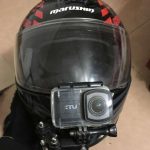In the shooting process of action cameras, the control and utilization of light is very important. A flash is a commonly used photographic equipment that provides the right amount of light to enhance a shot. However, using flash also requires skill and method. Improper use of the flash may cause problems such as being too dark, too bright, or reflections. This article will introduce how to properly use the flash during action camera shooting to get the best shooting effect.

Learn the basics of how a flash works
The basic working principle of the flash is to convert electrical energy into light energy through an electronic flash tube to produce a high-brightness flash. During the shooting process, the use of the flash can provide a short, strong light, making the subject clearer and brighter. However, excessive use of flash can also cause problems such as overexposure and reflections. Therefore, before using the flash, it is necessary to understand the basic working principle and characteristics of the flash in order to better control the effect of the light.
Choose the right flash
When choosing a flash, you need to choose a suitable lamp according to the needs of the shooting and the characteristics of the scene. Here are a few areas to be aware of:
- Brightness and range: Different flashes have different brightness and range; photographers need to choose the appropriate brightness and range to meet the shooting needs.
- Light source color: Different types of flashes have different light source colors, such as white, blue, or yellow. Photographers need to choose the appropriate light source color according to the needs of the scene.
- Flash mode: Different flashes have different flash modes, such as manual or automatic mode, etc. Photographers need to choose the appropriate flash mode according to their needs.
Control the brightness of the flash
When using a flash, photographers need to control the brightness of the flash to meet different shooting needs. Here are a few areas to be aware of:
- Flash position: The position of the flash affects its brightness and light direction. If the flash is too close to the subject, it can cause issues like overexposure and reflections. If the flash is too far away, it may cause insufficient light.
- Angle of the flash: The angle of the flash also affects its brightness and direction of light. If the angle of the flash is too low, it may cause too much light, and if the angle is too high, there may be not enough light.
- Brightness adjustment of the flash: The flash usually has a brightness adjustment function, and the photographer can make appropriate adjustments according to needs. During the shooting process, it can be adjusted according to different light conditions to obtain better shooting effects.
Flash Bounce Control
The flash may also produce reflection problems during shooting, which may lead to overexposure or reflection problems in the shot. Here are a few areas to be aware of:
- Use a flash diffuser: A flash diffuser can reduce reflections by turning hard flashes into soft light. Photographers can use the diffuser to control the light effect of the flash.
- Choose the right shooting angle: Photographers can choose the right shooting angle to avoid flash reflection problems. For example, the flash can be positioned to the side of the subject rather than in front of it.
- Control Light Intensity: Photographers can control the intensity of reflections by controlling the light intensity of the flash. When the light intensity is too high, the photographer can properly reduce the brightness of the flash to avoid reflection problems.
Summarize
During action came shooting, judicious use of the flash can provide better lighting effects. Photographers need to understand the basic working principle of the flash, choose the appropriate flash, control the brightness and reflection of the flash, in order to obtain the best shooting effect. At the same time, photographers also need to use flash flexibly according to the needs of the shooting scene, so as to gain more space for creativity and imagination.









